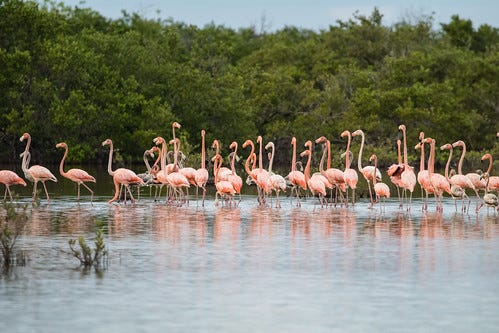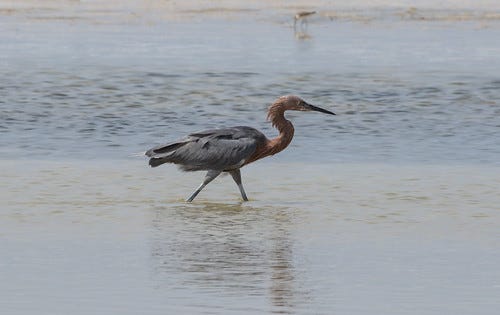(Listen to the radio version, Part 1, here, and Part 2 here.
When I started birding on March 2, 1975, I was hungry to see all the birds in the wild that I’d seen in zoos or read about in books. Within a few days I saw ducks, geese, pheasants, Blue Jays, crows, robins, and sparrows. I added hummingbirds, ravens, and a Snowy Owl that same year; a few more owls and Bald Eagle the next year; and swans, roadrunners, turkeys, cranes, and magpies while it was still the 1970s. Jack London’s wolf cub White Fang killed a brood of ptarmigan chicks and their mother in his first hunting adventure, so I was thrilled to see ptarmigans in Colorado in 1979.
I saw my first wild parrots—not native but an established population—in Texas in 1991, and wild macaws in Costa Rica in 2001. I was obsessed with Resplendent Quetzals after I read about them as a small child, and in 2001 when I finally saw one in Costa Rica, the actual event surpassed my greatest expectations. At this late date, it’s doubtful I’ll ever see a penguin or ostrich in the wild, nor a chicken or peacock in its natural native habitat in Asia, though I have seen what are established, if uncountable, introduced populations of those two in Florida.

But of all the iconic birds I’ve yearned to see in the wild, and worked hardest and longest to see, the most elusive has been the flamingo. Flamingos have never been common birds in the United States. John James Audubon saw some in the Florida Keys, but to his great regret, he never succeeded in shooting any. He did include them in his Birds of America, but the reference specimens for his famous illustration had been procured by others.
Audubon at least saw wild flamingos in Florida. I didn’t have his luck. Since my first trip there in 1988, I’ve spent a lot of time in the Florida Keys and the Everglades, including hiking the Snake Bight Trail, but with no luck, at least with regard to flamingos.
One person’s flamingo artwork may be even more famous than Audubon’s—Don Featherstone, who designed the original plastic lawn flamingos in 1957. Not being a bird shooter and unable to procure live flamingos to study, Featherstone used National Geographic photos as his reference materials. Back in the 90s, I assigned his unique creation its own scientific name—Flamingo tackyvulgaris. And all the flamingos I ever experienced until just 7 years ago were of the plastic variety or in zoos.
On October 13, 2016, when I was in Cuba, I saw my first wild flamingos—actually hundreds of them—a bit southeast of Havana in Parque Nacional Ciénaga de Zapata. They were what I call “lifer lifers”—wild birds I’d never ever seen before anywhere in the world. I got bazillions of photos and treasure the memory, but they didn’t count for what is called the “ABA Continental Area list”—birds seen in the wild in Canada and the United States outside of Hawaiʻi.
I spent the first quarter century of my birding life within this area, so even when I’ve had splendid opportunities to travel to other continents, the lifers on this list were special. I kept close track of my world life list until I reached 1,000 in 2001 with Russ in Trinidad and Tobago—that milestone species was the Bearded Bellbird.

I didn’t pay attention when I hit 2,000 at some point when I was in Uganda in November 2016. On that trip, I did see distant Lesser Flamingos in Queen Elizabeth National Park, but have no idea which of the 375 new birds I saw on that trip was #2,000. I only know that right now my world total is 2,182 because just this moment I looked it up on eBird.

I started 2023 with the firm idea that this was the year I’d finally see a flamingo in the wild in the United States. In April, I got some amazing American Flamingo closeup photos of captive birds at Discovery Cove in Orlando.
I took a birding tour of South Florida later in April. That’s the trip that got my ABA Continental List up to 700, but we didn’t see any flamingos.
Oddly enough, there has been a wild flamingo in Florida for the past five years—one lone individual nicknamed “Pinkie” ended up at the St. Marks National Wildlife Refuge south of Tallahassee after Hurricane Michael in 2018, and stuck around until just a few months ago, but when Russ and I drove to Florida in 2021, we didn’t have time to make the detour. Meanwhile, this August, Hurricane Idalia blew flamingos to places all over the eastern US, including Adams County, Wisconsin. Several issues kept me from chasing that one, but when Russ and I drove to Florida on October 7, we made the detour to St. Marks. I was very hopeful— “Pinkie” hadn’t been seen in weeks, but a few others had been blown in by Idalia—how could we miss?
But miss we did. We had a great time at St. Marks on October 10, and plan to make that a regular stop when we visit our son in Orlando—just not for flamingos. That evening when we got to Orlando, I checked out the most recent sightings on eBird and saw that flamingos had been seen that very day in two different parks in Pinellas County near Tampa—Fort De Soto and Fred Howard Park. This was a real family affair—our son Joe and of course our dog Pip came along. Traffic was horrific so we didn’t make it to Fort De Soto until after 1 pm, Russ and Joe hungrier for lunch than flamingos. It was a great park, and though the light was marginal, I got my best photos ever of a Reddish Egret. But no flamingos.
My finger still has its unwieldy splint for a few days, making driving tricky, so Russ was the one dealing with the horrible traffic all day, and now it was rush hour as we worked our way to Fred Howard Park. We arrived about 4:30, the threatening, overcast sky making it seem closer to night than it was.
I was braced for disappointment. The very nature of birds makes it hard to predict where an individual or group will be at any particular moment, and I had known from the start that this entire day could end up as a wild goose chase. Really, why should it be any different from the many other days that I’d spent in hopes of seeing a flamingo? I was plenty happy with that Reddish Egret.
As often happens when I’m birding with family members, Russ and Joe were more invested in my seeing the bird than I was. It’s the nature of people to expect a payoff the harder we try to do anything, and the nature of love to want someone you care about to reach their goals even more than you want to reach your own goals. Maybe it’s because he cared so much that it was my non-birding son who spotted the flamingo first—an immature standing alone near a very active Little Blue Heron and a bunch of loafing Laughing Gulls, Royal Terns, and Black Skimmers.
It sat in shallow water, its head resting on its back, but after a few minutes it raised its head, showing off its unique flamingo beak. A few minutes after we found it, the rain started. Russ positioned the car so I could continue to savor it and take photos out the window.
We were each a combination of elated and relieved during the long drive back. Sharing this most yearned-for bird with Russ and Joe made the experience even more memorable and magic. Florida is no longer a welcoming place for immigrants of the human variety, but maybe a poor undocumented bird blown in on a hurricane can enjoy a safe haven until it’s ready to find its way home.













